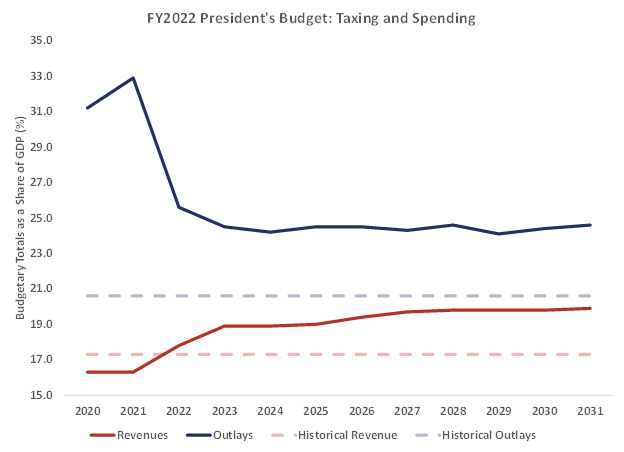Insight
May 28, 2021
Highlights of FY2022 President’s Budget
By the Numbers
Taxes: The President’s Budget assumes substantially increased tax revenue, both as a function of assumed growth and through proposed tax increases. The Office of Management and Budget (OMB) estimates that the President’s Budget proposes 3.6 trillion in tax increases. OMB’s HH baseline assumes $2.1 trillion more in revenue collection than does the Congressional Budget Office (CBO). Revenues in the President’s Budget are projected to increase as a share of gross domestic product (GDP), from somewhat below the 50-year average of 17.4 percent to 19.9 percent of GDP – 2 percentage points above the 50-year average. Over 10 years, the Biden Administration’s budget proposes an average level of taxation of 19.3 percent, nearly a percentage point higher than any 10-year period in the history of the modern U.S. tax system.
Spending: By the end of the budget window, the President’s Budget would increase spending by nearly $8 trillion over the next 10 years, compared to CBO’s baseline. As a share of GDP, spending would reach 24.6 percent of GDP, 4 percentage points higher than the 50-year average by 2031. Over the next decade, spending would average 24.5 percent of GDP. There has never been a 10-year period in U.S. history with this level of spending as a share of GDP – even inclusive of World War II.
Deficits: The President’s Budget assumes projected deficits total $14.5 trillion over the next decade. OMB estimates the deficit will decline from $3.7 trillion this year to nearly $1.6 trillion in 2031. Deficits are projected to exceed $1 trillion every year over the next decade.
Interest Payments: Interest payments on the debt will reach $914 billion in 2031. This reflects a more than doubling of debt service costs of $345 billion in 2020. The $914 debt service costs exceed the budget requests for every federal agency in FY2022.
Debt Held by the Public: Borrowing from the public would increase as a share of the economy under the President’s Budget, increasing from an all-time high in FY2021 of 109.7 percent of GDP to 117 percent of GDP in 2031. Even during World War II, the debt never reached these levels.
Economic Projections
The President’s Budget includes slightly more optimistic economic projections than does CBO in terms of real GDP growth, unemployment, and interest rates. Under the president’s budget, real GDP is assumed to grow about 0.2 percentage points faster than under CBO, while OMB assumes, on average, 0.4 percent lower unemployment and 0.1 percent lower 10-year Treasury rates. These effects combine to increase tax revenues and reduce debt service. Indeed, persistent, higher growth of just 0.1 percentage points should lead to about $200 billion in deficit reduction.












